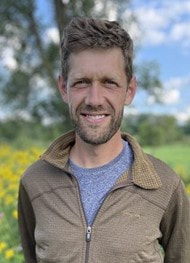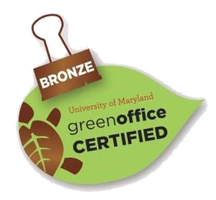[Seminar Blog] Designing and managing agricultural landscapes for insect driven ecosystem services4/2/2024
 Dr. Nate Hann Dr. Nate Hann written by: Brendan Randall & Angela Saenz A brisk, foggy morning; the sun rises on a midwest farm. Corn stalks sway for as far as the eye can see, seemingly the only life around. If one looks carefully, however, one will find the farm is teeming with life. Dr. Nate Haan is fascinated by the diversity of organisms on farms and how we can understand their ecology to improve farm sustainability and conservation of native biodiversity. Now an assistant professor in the Entomology Department at the University of Kentucky (UK), he is excited to answer fundamental questions about how farm management practices affect insects. In his seminar talk, Dr. Haan presented various approaches to test his central research question–does management affect insects in agricultural landscapes? Dr. Haan’s recent work looked at the effects different bioenergy crops have as enhancers of natural pest suppression. Bioenergy crops are grown for their biomass converted into fuel for human use. For example, corn-based ethanol is a biofuel commonly blended with the gasoline we use in our cars and trucks. Natural pest suppression is a farm management technique that utilizes naturally occurring organisms on a farm to control pests that damage crops, potentially reducing the need for pesticides. Natural pest suppression is also an example of an ecosystem service, or the benefits derived from ecosystems that are of value to humans [1 & 2]. According to the International Panel on Climate Change, bioenergy crops could offer a more sustainable alternative to fossil fuels and mitigate greenhouse gas emissions [3]. These crops, however, may have unintended negative consequences on ecosystems. The widespread planting of bioenergy monocrops converts natural areas into landscapes with low biodiversity [4]. Biodiversity and ecosystem services are inextricably linked. Reducing biodiversity can negatively impact natural pest suppression [5] and by designing farms and agricultural landscapes that enhance biodiversity, Dr. Haan posits that we can increase natural pest suppression and, therefore, the ecosystem services. Working as a postdoc in Dr. Doug Landis’ lab at Michigan State University, Dr. Haan posed a series of questions. How do landscape composition (amounts of crop and non-crop habitats) and configuration (size, shape, and arrangement of habitats) affect insect biodiversity and natural pest suppression? Do some bioenergy crops provide more ecosystem benefits than others? To answer these questions, he and his team ran a field experiment at Michigan State University’s Kellogg Biological Station, comparing different bioenergy cropping systems: annual monocultures (corn, sorghum), simple perennial monocultures (switchgrass and clover), and complex perennial polycultures (native prairie mixes). Within each treatment, plots were classified as “simple” if they contained mixtures of grasses, and “complex” if they contained mixtures of multiple types of plants that differ in size and shape, such as grasses, forbs, and legumes. Plots were visually surveyed for insect populations three times over the growing season, insect populations were also quantified and identified using pitfall traps. The amount of “predation” occurring in each plot was also estimated using plasticine clay caterpillar lures (Fig. 1). The results of these efforts demonstrated that plant-diverse, complex perennial systems had the largest insect biodiversity gains as compared to both low-diversity, simple perennial systems and annual monocultures (see Haan et al., 2023 for further details). In addition, more predation from chewing arthropods usually occurs in high-diversity, complex perennial systems. Farmers, Dr, Haan concluded, may benefit from this increase in natural enemies, and, therefore, reduce their need for pesticides.
Kentucky is home to over two million cows [6]. After working with bioenergy systems, Dr. Haan relocated to the University of Kentucky and is now pursuing his research interests within agricultural landscapes where pasture for grazing cattle predominate. Specifically, he plans to consider how dung beetle communities, which provide important ecosystem service such as soil aeration and pasture fouling prevention, are impacted by the widespread use of toxic parasiticides given to cattle. American livestock are regularly administered parasiticides such as avermectins (macrocyclic lactones) to treat a variety of pests and parasitic worms. Macrocyclic lactones remain active even after excreted and can have non-target effects on invertebrates, especially dung fauna. Dung beetle communities are amazingly complex, with multiple types of beetles such as rollers, dwellers, and tunnelers, but they all have one thing in common: both their larval and adult stages eat dung. Dr. Haan and his team are just starting this work. Over the next couple of years, they hope to measure the effects these parasiticides have on dung beetle diversity and community composition through different landscapes. To do so, they will deploy livestock dung-baited pitfall traps (with pig, sheep, and cow dung) in over 80 different Kentucky sites. These sites were strategically selected from a land cover gradient ranging from forested to managed lands to assess species diversity over various landscapes and verify if their composition changes as land use changes. Dr. Haan and his team will measure the captured beetle’s diet via gut content and toxicology analysis. They think morphological analysis will provide insights into the impact of diet on their horn length. Contact with parasiticides can impact dung beetles in many ways, including affecting male morphologies like horn length, which in turn could affect their reproductive success. While diet is known to affect horn length [7], the relationship between ivermectin and male horn length remains unknown, and the effects of this parasiticide on other species of the dung community that live on other landscapes is one of the questions his project is trying to address. Overall, Dr. Haan’s compelling work intends to broaden our knowledge of the impact of different farming practices – planting complex, diverse landscapes, and cattle parasite management -- on insect diversity factors. Enhanced insect diversity could improve ecosystem services. This knowledge could empower farmers with knowledge to create more sustainable farms and communities. Brendan Randall is a PhD student in the Burghardt lab studying how rhizobia bacteria mediate plant-insect interactions in soybeans. Angela Saenz is a PhD student in the Gruner lab, and her research focuses on the synchrony and phenology of the Emerald Ash Borer and its introduced natural enemies in forested areas. Citations [1] Costanza, R., d’Arge, R., de Groot, R., Farber, S., Grasso, M., Hannon, B., Limburg, K., Naeem, S., O’Neill, R. V., Paruelo, J., Raskin, R. G., Sutton, P., & van den Belt, M. (1997). The value of the world’s ecosystem services and natural capital. Nature, 387(6630), 253–260. https://doi.org/10.1038/387253a0 [2] Mengist, W., Soromessa, T., & Feyisa, G. L. (2020). A global view of regulatory ecosystem services: Existed knowledge, trends, and research gaps. Ecological Processes, 9(1), 40. https://doi.org/10.1186/s13717-020-00241-w [3] Chum, H., A. Faaij, J. Moreira, G. Berndes, P. Dhamija, H. Dong, B. Gabrielle, A. Goss Eng, W. Lucht, M. Mapako, O. Masera Cerutti, T. McIntyre, T. Minowa, K. Pingoud, 2011: Bioenergy. In IPCC Special Report on Renewable Energy Sources and Climate Change Mitigation [O. Edenhofer, R. Pichs-Madruga, Y. Sokona, K. Seyboth, P. Matschoss, S. Kadner, T. Zwickel, P. Eickemeier, G. Hansen, S. Schlömer, C. von Stechow (eds)], Cambridge University Press, Cambridge, United Kingdom and New York, NY, USA. [4] Immerzeel, D. J., Verweij, P. A., van der Hilst, F., & Faaij, A. P. C. (2014). Biodiversity impacts of bioenergy crop production: A state-of-the-art review. GCB Bioenergy, 6(3), 183–209. https://doi.org/10.1111/gcbb.12067 [5] Haan, N. L., Zhang, Y., & Landis, D. A. (2020). Predicting Landscape Configuration Effects on Agricultural Pest Suppression. Trends in Ecology & Evolution, 35(2), 175–186. https://doi.org/10.1016/j.tree.2019.10.003 [6] Knopf, D. Kentucky January 1 cattle inventory. USDA. NASS. https://www.nass.usda.gov/Statistics_by_State/Kentucky/Publications/Current_News_Release/2022/Cattle22_KY.pdf (accessed on 02/21/2024). [7] Emlen, D. J. (1997). Diet alters male horn allometry in the beetle Onthophagus acuminatus (Coleoptera: Scarabaeidae). Proceedings of the Royal Society of London. Series B: Biological Sciences, 264(1381), 567-574. Comments are closed.
|
Categories
All
Archives
June 2024
|
Department of Entomology
University of Maryland
4112 Plant Sciences Building
College Park, MD 20742-4454
USA
Telephone: 301.405.3911
Fax: 301.314.9290
University of Maryland
4112 Plant Sciences Building
College Park, MD 20742-4454
USA
Telephone: 301.405.3911
Fax: 301.314.9290


 RSS Feed
RSS Feed




